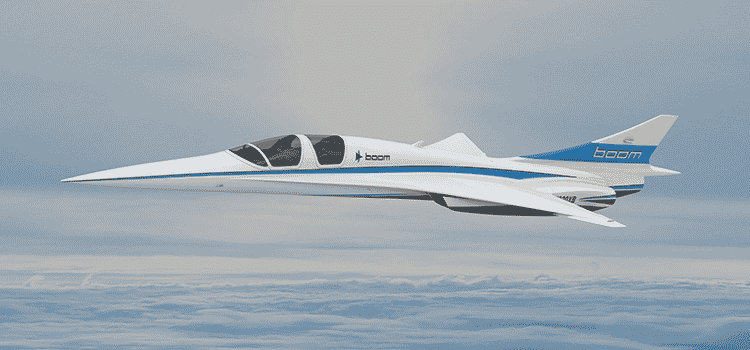Cloud HPC Simulation Enables Boom’s Supersonic Passenger Jet to Take Off
Background and Challenge
Boom Supersonic is an aerospace startup that is redefining passenger air travel. They are designing a supersonic passenger jet that will take business travelers from San Francisco to Tokyo in 5.5 hours, revolutionizing business travel and revitalizing a long stagnant industry. Only a few years old, they are already backed by significant funding and have secured over 75 advance orders from airlines around the world.
Boom’s innovation comes more than 40 years after the introduction of the Concorde, an engineering marvel but an economic disappointment. Many years later, using cutting-edge simulation combined with cloud technology, Boom is setting out to accomplish what Concorde could not: a sustainable business model. Creating a technological breakthrough is not easy in the aerospace sector. It traditionally requires billions of dollars in R&D, a small army of engineering staff, extensive wind tunnel testing, and many years of development. More recently, advanced fluid-flow and mechanical stress simulation tools have reduced physical testing requirements and costs, but they require costly dedicated high performance computing (HPC) resources to be effective.
As a small startup with limited funding but outsized dreams, Boom turned to the public cloud because the upfront costs of building their own on-premise HPC cluster were cost-prohibitive. The company briefly considered developing their own software infrastructure and middleware for spinning up compute clusters on the public cloud on-demand, but the IT and software development resources required for that, too, were cost-prohibitive.

Needing immediate burst capability and pay-as-you-go compute clusters without the time and expense of setting up their own software and hardware infrastructure, Boom has run all their simulations on Rescale’s enterprise big compute platform since day one. Rescale offers Boom virtually unlimited compute capacity, while allowing them to bypass investment in internal IT capability—both incredibly valuable to an early stage startup with limited funding. In essence, Rescale enables Boom—and their technology—to get off the ground.
The Rescale Solution Today
Boom uses Rescale’s ScaleX® platform primarily for aerodynamic analysis of the full airplane. For example, they run simulations of supersonic inlets designed to slow incoming air to the optimum temperature, pressure, and velocity for the jet engine. They use two NASA-developed CFD software applications: Cart3D, licensed by Aerion Technologies, and Fun3D. These codes are just two of the 250+ software applications that are available natively-integrated and optimized on the ScaleX cloud platform.

Rescale provides a turnkey interface between advanced engineering software and HPC hardware in the public cloud, allowing Boom to focus on their core engineering competency without distraction from IT management tasks.
In addition to allowing Boom to forego in-house IT, Rescale further vastly simplifies IT management with the ScaleX Enterprise administration portal, which allows Boom to manage costs with budgets for projects and teams, manage teams with custom permissions for hardware and software, and manage security with features such as multi-factor authentication and single sign-on. To comply with the additional security layers required for aerospace and defense technologies by the International Traffic in Arms Regulations (ITAR), Boom runs all their simulations on Rescale’s designated ITAR-compliant platform.
Using Rescale’s ScaleX platform, Boom runs Navier-Stokes unstructured CFD simulations of the flight envelope, especially the flight states involving vortex lift. Simulating vortices over the wing requires dense meshing, often with more than 200 million cells, and thus HPC.
“Rescale’s cloud platform is a game-changer for engineering. It gives Boom computing resources comparable to building a large on-premise HPC center. Rescale lets us move fast with minimal capital spending and resources overhead.” Joshua Krall, Co-founder & CTO at Boom Supersonic
Boom spins up these jobs on customized clusters in the cloud via the ScaleX platform, enabling these highly compute-intensive jobs to complete in minutes to hours, depending on their complexity. Boom often does parametric design exploration over the whole wing, allowing them to test different geometry alternatives to achieve their design goals.

Such compute-intensive simulations realistically require HPC clusters to run, and Boom is able to launch these jobs on the cloud through Rescale’s big compute platform. Cloud hardware configurations are scalable and pay-as-you-go, such that Boom can scale out their simulations and reduce run times according to budgetary and project time constraints. Boom regularly runs their simulations on 512 cores, although Rescale’s global network of cloud resources allows them to scale out much more.
The Benefits
With Rescale, Boom has been able to revitalize a stagnant industry segment through revolutionary engineering design. Their achievement and progress to date as a lean startup operation challenges the conventional wisdom that substantial upfront capital is required to compete with industry giants such as Boeing and Airbus.
Their ability to scale their simulation on-demand and control their spending with pay-as-you-go pricing has enabled them to do the following:
- Increase simulation throughput and reduce time to market: Each Boom engineer is able to evaluate 100 design configurations at once to achieve more than 6x speedup for each job compared to a typical workstation. Parallelization of jobs improves simulation turnaround time dramatically.
- Scale the business quickly: As the company rapidly grows it is important to keep engineer onboarding time to a minimum while continuing to accelerate simulation throughput. The automation of the company’s simulation workflow and centralized data management on the Rescale ScaleX platform have been critical to reduce the learning curve for new employees.
- Eliminated IT overhead: Boom was able to bypass the development and maintenance of an in-house IT department to manage their data. Instead, they are able to focus 100% on product development.
